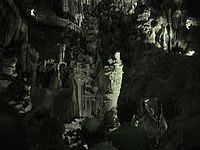
Grotte des Demoiselles
Encyclopedia

Hérault
Hérault is a department in the south of France named after the Hérault river.-History:Hérault is one of the original 83 departments created during the French Revolution on 4 March 1790...
valley of southern France
France
The French Republic , The French Republic , The French Republic , (commonly known as France , is a unitary semi-presidential republic in Western Europe with several overseas territories and islands located on other continents and in the Indian, Pacific, and Atlantic oceans. Metropolitan France...
, near Ganges
Ganges, Hérault
Ganges is a commune in the Hérault département in Languedoc-Roussillon in southern France.-Location:Ganges is situated at the confuence of the Hérault and Rieutord rivers.-History:...
, about 60 km (38 mi) west of Nîmes
Nîmes
Nîmes is the capital of the Gard department in the Languedoc-Roussillon region in southern France. Nîmes has a rich history, dating back to the Roman Empire, and is a popular tourist destination.-History:...
. Its entrance is located on the territory of the commune of Saint-Bauzille-de-Putois
Saint-Bauzille-de-Putois
Saint-Bauzille-de-Putois is a commune in the Hérault department in Languedoc-Roussillon in southern France.-References:*...
.
History
Many legends and stories have been linked with the cave, the existence of which has been common knowledge in the LanguedocLanguedoc
Languedoc is a former province of France, now continued in the modern-day régions of Languedoc-Roussillon and Midi-Pyrénées in the south of France, and whose capital city was Toulouse, now in Midi-Pyrénées. It had an area of approximately 42,700 km² .-Geographical Extent:The traditional...
region since time immemorial. The best known legend tells of a shepherd looking for a lost lamb who wandered into the swallow hole that marked the entrance to the cave. He heard the lamb but could not see it, and so he continued deeper and deeper into the cave, until he reached the chamber now known as the cathédrale (cathedral). With only a torch for light, he slipped and fell to the bottom of the chamber (a 60-metre plunge between stalactite
Stalactite
A stalactite , "to drip", and meaning "that which drips") is a type of speleothem that hangs from the ceiling of limestone caves. It is a type of dripstone...
s and stalagmite
Stalagmite
A stalagmite is a type of speleothem that rises from the floor of a limestone cave due to the dripping of mineralized solutions and the deposition of calcium carbonate. This stalagmite formation occurs only under certain pH conditions within the underground cavern. The corresponding formation on...
s). Knocked senseless by the shock, he noticed—just before passing out—a group of young ladies dancing and singing around him. When he woke up, he was back on the surface with his lamb. The modern name of the cave, Grotte des Demoiselles (“maidens' grotto”) reflects this legend; previously it had been known as the Grotte des Fées (“fairies' grotto”).
At various times in history the cave has also served as a hiding place and refuge.
In 1889, more serious exploration of the cave was undertaken by the renowned speleologist
Speleology
Speleology is the scientific study of caves and other karst features, their make-up, structure, physical properties, history, life forms, and the processes by which they form and change over time...
Édouard-Alfred Martel
Édouard-Alfred Martel
, the 'father of modern speleology', was a world pioneer of cave exploration, study, and documentation...
. At the time, visiting the cave was quite perilous, but in 1931 a funicular
Funicular
A funicular, also known as an inclined plane or cliff railway, is a cable railway in which a cable attached to a pair of tram-like vehicles on rails moves them up and down a steep slope; the ascending and descending vehicles counterbalance each other.-Operation:The basic principle of funicular...
, concrete stairs and walkways with sturdy railings and extensive electric lighting were installed to make it accessible to the general public; and since then it has been a popular regional tourist attraction.
Formation of the cave
The Grotte des Demoiselles is thought to have initially been formed by the collapse of overlying limestoneLimestone
Limestone is a sedimentary rock composed largely of the minerals calcite and aragonite, which are different crystal forms of calcium carbonate . Many limestones are composed from skeletal fragments of marine organisms such as coral or foraminifera....
, made fragile by water erosion
Erosion
Erosion is when materials are removed from the surface and changed into something else. It only works by hydraulic actions and transport of solids in the natural environment, and leads to the deposition of these materials elsewhere...
. However, some doubt remains as to the source of the water: it may have been an underground stream that has now disappeared, or it may have been a stream that is now about 300 metres (980 years) lower, although no link with the latter has been discovered thus far.
External links
- La Grotte des Demoiselles Official site (in French)

